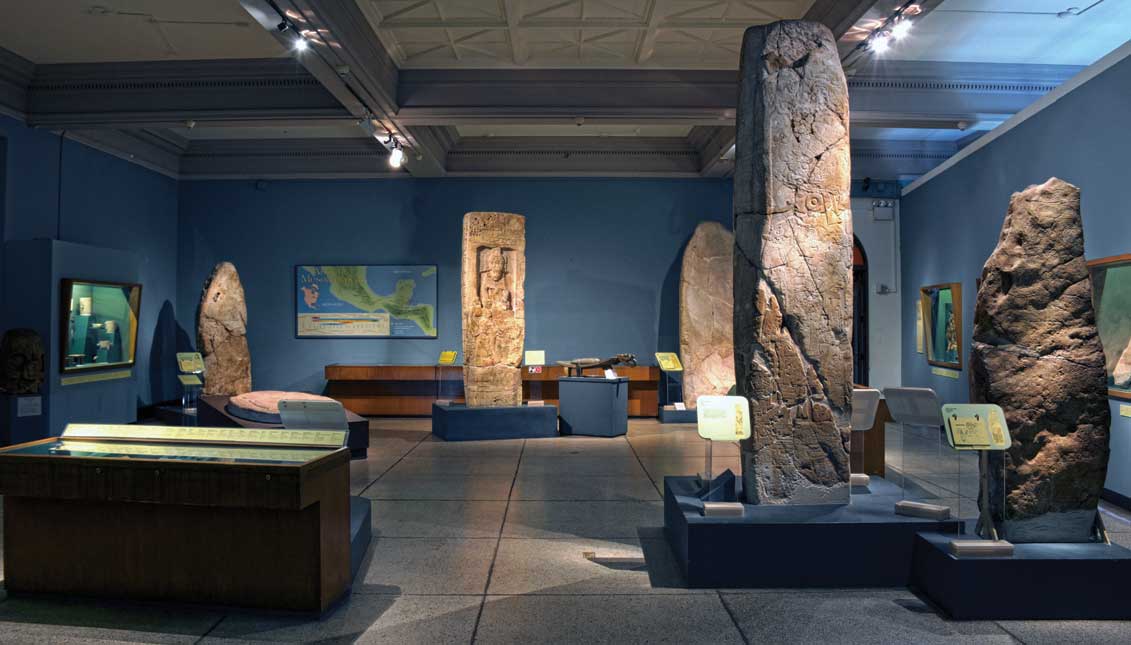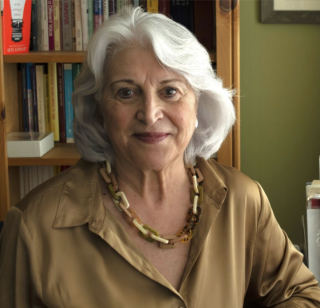
In Search of the Maya World: From Central America to Philadelphia
One of the most intriguing mysteries of Latin American culture is what happened to the Maya civilization. How come after over 3,000 years of history, from…
Last month I set out on a trip through Central America with a small group of Road Scholars in search of the mysterious Maya World. Little did I know at the time that there are so many connections between Maya culture and Philadelphia.
The first archeological site on the itinerary was Lamanai (“Submerged Crocodile” in Mayan language), situated in a tropical forest on the banks of the New River Lagoon in Belize. The Mayas used waterways to trade with each other and we accessed the site by motor boat. Lamanai was a large, ceremonial center, built in layers by succeeding generations in the Pre-Classic Period (2,500 BC – 250AD). The Jaguar Temple and the Masks Temple with its impressive sculptures are some of the highlights of this site. The steep climb to the top of the High Temple, one of the largest of this period, was well-worth it for the panoramic view of the jungle and the lagoon. Unlike the Egyptians, the Mayas did not necessarily bury their rulers in these pyramids. Maya temples were built mainly to honor their rulers and their gods; special offerings of jade and shell ornaments were recovered at this site. Cahal Pech, another ceremonial center in Belize, is known for being one of the earliest in the region. Its 34 structures consist of two small ball courts, palaces and temples with stelae (stone monuments) and altars.
The anthropologists don’t agree on the symbolism of the Maya ball games, but given the prominence of the ball courts, it is believed that it was much more than a spectator sport. The size of the ball courts varies, they can be over a hundred meters long by thirty wide. They are always rectangular with an average length-to-width ratio of 4-to-1, with side walls. The ball game was played with a rubber ball the size of a human head, among two or three players and sometimes in small teams. The men wore protective gear around the waist, since the ball was hit with the hips, knees and elbows but not the feet or hands. Often there was a circle for the ball to go through; sometimes the ball had to reach the end zone. In any case, there is evidence that some of the players were sacrificed to the gods, because the games symbolized the struggles between life and the underworld. Thus the ball court can be found, as in Tikal, in front of the main pyramids.
Tikal National Park in Guatemala is, without a doubt, the most impressive archeological site we visited. It contains over 4,000 structures; no wonder that a Star Wars movie was filmed there! Situated high above the Petén Jungle, it is a UNESCO World Heritage Natural and Cultural Site. It flourished for 1,500 years until 900 years AD approximately and it was known for its architectural, astronomic, agricultural and commercial development. It is believed that during its height, more than 50,000 people lived there. Six of the tallest temples in the Maya world are found here; some are over 200 feet tall with their characteristic crested roof comb. There are also twin pyramid groups believed to have been erected to commemorate a katun or a period of twenty 360-day years.
Typically the Maya pyramids were erected on top of each other to commemorate succeeding kings as is the case in Tikal. The North Acropolis and its temples were burial grounds rebuilt many times. One of these buildings is believed to be the burial site of King Ah Cacau´s queen, judging from the remains and the portrait of a royal woman found there.
For centuries, Maya hieroglyphic writing was one of the biggest mysteries of its culture. But thanks to the pioneer work in 1952 by the Russian Yuri Knorosov, it was shown that the hieroglyphs could be read as phonetic syllables. And in 1960, a scholar from the University of Pennsylvania, Tatiana Proskouriakoff, was able to identify major historical events in the lives of the ancient Maya kings based on the monumental inscriptions. Not surprisingly, during our trip to Central America, there were many references to her research and the work done in various archeological sites, such as Tikal and Copán, by archaeologists from the University of Pennsylvania.
Although most of the architectural monuments and inscriptions depict the accomplishments of the Maya kings and gods, we know quite a bit about the role of women in that society. Proskouriakoff, the first female Mayanist, was also the first to decipher the glyph for “woman.” Before that, many carvings and inscriptions were thought to be of priests in long robes, when they were women actually wearing the traditional huipil dress that Maya women wear to this day. Women were important in the court for their role as mothers of the kings and their marriage alliances, particularly during the 7th and 8th centuries. Some women were thought to have supernatural powers, like Ixchel or Lady Rainbow, the patron of childbirth and the Moon Goddess, associated with femininity and the mythology of maize.
Women were also represented in the traditional roles of mother, cook and weaver. Although there are practically no surviving textiles, it is known from the carvings and paintings that Maya women used a loom very similar to the one still used today. Their bones found in burial sites show how their knees were deformed from continuous kneeling, something that is not evident in the skeletons of the women of the court. Textiles were very important in the Maya culture; they were used for gifts and for trade. Often their designs included special dyes, feathers, jade or shell ornaments and they had mythological significance. Palm trees were used to make baskets and mats for sleeping, also made by women. It is worth noting that women were not represented as warriors, scribes or artists, these roles were reserved strictly for men.
The last major archeological site we visited was Copán in Honduras, another World Heritage Site and the most easterly of the Maya cities, known for its magnificent ornate, florid sculptures. Although Copán was only a small farming community at first, it grew to be an important centre for the study of astronomy and astrology in the 9th century with more than 20,000 inhabitants. In addition to its Hieroglyphic Stairway to the underworld and numerous stelae, Copán is famous for what archaeologists have called Altar Q, a square sculpture with sixteen figures, four on each side. Each of these figures represents a king of the Yak K’uk Mo’ dynasty, with its last king Yax Pak receiving the scepter, symbol of sovereignty, from his father. The Copán Archeological Museum, in addition to many original sculptures, holds a colorful replica of the spectacular Rosalila Temple facade. Although Maya ruins don’t have much color, originally many were decorated in bright paint.
One of the most colorful scholars that we met on our trip, was David Sedat, the retired field director of the University of Pennsylvania Museum of Archeology and Anthropology, who has studied Maya culture since the 1970s and now lives in Copán. He was instrumental in the discovery of the royal tombs in the Acropolis under the auspices of the University of Pennsylvania, starting in 1989. In 1993 archeologists found a spectacular, rich tomb they thought belonged to Yak K’uk Mo´s son. The tomb contained over 2,000 objects made of jade and mother of pearl, as well as baskets, pottery items and mirrors. Soon an analysis of the remains showed that the skeleton belonged to a nameless woman. Now it’s thought that this woman was one of the king’s wives and her burial place is known as “The Margarita Tomb” or “the Lady in Red” since her bones were painted with red cinnabar. It seems that she was associated with the symbols of the Moon Goddess.
RELATED CONTENT
Sedat explained to us that “Copán is often called the Athens of the Maya world because it was a great center of culture and learning, as well as a pilgrimage site during the Classic era” (250-900 AD). He compares Guatemala’s Tikal to Hondura’s Copán like New York is to Paris “if you think of Tikal as an ode to soaring pyramids and temples and Copán as a toast to artistic and cultural achievement.”
Currently, Sedat runs The Copán Botanical Research Station, which he founded in 2003. According to him, the Maya collapse was due to: “Unrestrained population growth, deforestation and erosion of hill slopes, loss of farm land and diminished water resources and nutritional deficiencies.” His intention is to regenerate the land in order to avoid a similar catastrophic situation in the present.
[node:field_slideshow]
Needless to say, upon my return to Philadelphia, I had to visit the museum in the University of Pennsylvania campus. The Mexico and Central America Gallery is a large, central room situated on the main floor. The most notable Maya stone monument is Stela 14 (758 AD), which is the stela that Tatiana Proskouriakoff used to decode the royal life histories mentioned earlier. It celebrates the accession of Ruler 5 of Piedras Negras, Guatemala. The king is wearing an elaborate headdress, beaded pectoral and waistband and a decorated loincloth. Underneath him stands a woman, also with a headdress of ceremonial feathers, who is offering tokens to him. According to Simon Martin, the University of Pennsylvania Museum curator of Maya hieroglyphics, she was probably his mother. There are other exquisite artifacts crafted of jade, obsidian and ceramic figures in addition to copious information about Maya society, like their use of cocoa and maize. An entire display on the ball game includes a protective yoke in perfect condition. If you can’t make the trip to Central America, don’t miss this exhibit!
Simon Martin agrees with Sedat in that the demographic collapse of the great Maya cities of Mesoamerica was probably due to an ecological decline, such as a major draught, deforestation and soil erosion. It is obvious to him that the rulers and noblemen were fighting among themselves, but he sees this as a symptom of the dire situation, not the cause of the fall. Martin is sure that through modern technological advances such as Lidar laser light, archeologists will find out eventually what happened to the great Maya cities. So, stay tuned!
Although it should not be assumed that all Guatemalans and Hondurans who live in Philadelphia would be descendants of the Mayas, it is worth noting that there is a significant number of immigrants from those two countries and they bring their indigenous culture with them (without forgetting the larger number of Mexicans, who may also have Maya roots). According to the 2010 Census, Guatemalans are the fifth largest Latino group in the United States and the second largest Central American population after Salvadorans. In Philadelphia there are thousands of immigrants from Honduras and Guatemala, many coming after 2005 when hurricane Stan caused significant damage in Central America. They live throughout the city, particularly in North and South Philadelphia and the Spring Garden area as well as the suburbs of Olney and Feltonville.











LEAVE A COMMENT: